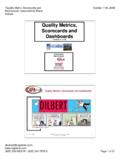Transcription of Metrics transformation in telecommunications - EY
1 Metrics transformation in telecommunicationsMeeting the challenges of communicating performance in a shifting industry landscapeLegacy Metrics cannot capture today s growth and profitability01 02 03 06 Strong industry growth fuels capex concernsWhy change and why now?An uncertain outlook ..08 10 12 Customer Metrics need to reflect new use casesTackling the pros and cons of EBITDAThe business case for new financial metrics1617 SummaryThe factors challenging legacy metricsContactsContentsMetrics transformation in telecommunications1 Metrics transformation in telecommunicationsThe changes impacting the industry are pervasive and profound, and they occur in several dimensions. Operators profitability remains under significant pressure, driven by rising customer sophistication and demand, ongoing price pressures exacerbated by intensifying competition from over-the-top (OTT) providers and regulatory pressures on core service as traditional markets become saturated, the business case for investment by operators is no longer driven by net additions and rising penetration.
2 Many markets are now hyper-penetrated, while churn remains low despite intense pricing pressure. Yet long-term capex requirements remain high. And future growth opportunities increasingly involve new types of customers, connectivity, use cases and profitability profiles with even the traditional definitions of customer or user coming under is also under way on the investor side as shareholders and analysts increasingly look for new sector growth stories in the wake of infrastructure upgrades. Meanwhile, operators themselves are squaring up to the challenge of improving their business intelligence capabilities as a catalyst for better decision-making. This in turn requires a more robust set of internal Metrics that capitalizes on the wealth of product and customer data they have at their Metrics for a new environmentThese combined fundamental shifts mean that new Metrics are needed to measure the industry s health and performance.
3 Robust and relevant operational and financial Metrics are critical to support informed decision-making across the industry, maintain the credibility and relevance of operators reporting and forecasts, and sustain investors confidence. If the Metrics used by the industry are to continue to play these roles, it is vital that they keep pace with changing market conditions, business models and service offerings. It is also important to maintain global consistency in these new and evolving Metrics as operators widen their service propositions and as investors and regulators demand new insights into addressable markets and end users. Why change and why now?Across the global telecommunications industry, the fast-changing technological, competitive and customer environment is calling for a renewed look at the Metrics operators use to measure and report their financial transformation in telecommunications2 Strong industry growth fuels capex concernsThe global telecoms sector is outpacing the market s previous assumptions on its growth rate because of soaring usage of data services.
4 Yet concerns persist over the costs required to support this exploding demand for current wave of growth in mobile data services and traffic is driving connections and handset penetration ever higher. As the long tail of emerging market users gets connected, the number of mobile connections is projected to surpass the global human population in 2014 (see Figure 1). Demand for data is being further increased by trends such as consumers aggregating devices and embedded SIM and machine-to-machine (M2M) : Mobile Regional and Country Forecast 2012 2017, Ovum, August 2012; US Census BureauFigure 1. Global population and mobile connections02,0004,0006,0008,000 Millions10,00020102012201120142013201620 172015 Global populationMobile connectionsFigure 2. Annual smartphone shipmentsSource: Worldwide Smartphone 2012 2016 Forecast Update, IDC, September 201201020304050607002004006008001,0001,2 001,400201120122013201420152016 Smartphone shipmentsSmartphones as % of all handsetsMillions%At the same time, global smartphone shipments are continuing to ramp up impressively (see Figure 2).
5 However, minutes of use (MoU) is flattening in some markets as consumers usage shifts toward data and away from traditional services such as voice, despite a rising proportion of packages offering unlimited minutes and text messages. Metrics transformation in telecommunications3 Investors view of the telecoms sector remains fundamentally ambivalent, reflecting uncertainty over the trade-off between the costs and value of new growth areas. A further factor is the difficulty of assessing operators future capex commitments as mobile traffic growth outpaces mobile data revenue growth (see Figure 3).. threatens the sector s defensive qualitiesThis uncertainty means the capex guidance for many operators remains conservative, despite the strongly rising demand for mobile data. A subdued perception of growth potential, coupled with macroeconomic pressures, has seen telecoms stocks Figure 3. Global mobile data revenue and traffic growthSource: Mobile Regional and Country Forecast 2012 2017, Ovum, August 2012; Cisco Visual Networking Index 2011 2016, May 201202,0004,0006,0008,00010,00012,00014, 0000100,000200,000300,000400,000500,0006 00,000201120122013201420152016 Mobile data revenueMobile data trafficRevenue (US$m)Traffic (PB per month)An uncertain outlook.
6 In combination, these trends are projected to see the proportion of global mobile revenues derived from data services rise from 29% in 2010 to 48% in 2017, reflecting a fundamental shift in product and revenue as a defensive play offering strong cash flows. Yet even this view of the industry is now under pressure in the wake of dividend cuts announced by leading comparison of major telcos share performance over the past five years highlights defensive qualities giving way to underperformance in 2012 (see Figure 4). Overall, the industry s performance has been resilient but unexciting over this period and it is clear that ongoing macroeconomic and structural pressures 4. Telecoms stocks performance (rebased)Source: *Dow Jones and MSCI from Capital IQ, Thomson ONE, accessed January 2012 Dec 07 Jun 08 Dec 08 Jun 09 Dec 09 Jun 10 Dec 10 Jun 11 Dec 11 Jun 12 Dec 12200406080100120 Dow Jones telecommunications EURO STOXX TelecomMSCI AC Asia/Telecom ServicesFirst economic crisis telecoms decline less pronounced than other sectors as they are seen assafe-haven stocksTelecoms stocks recover, but rebound underperforms other sectors, reflecting structural sector weakness, , regulation, price competitionUS telecoms outperform US all-market index due to confidence in continued smartphone take-up and cross-selling opportunities, , pay-TVEuropean telecoms underperform other sectors in 2012 due to macroeconomic pressures, particularly in mobile.
7 And concerns over dividend sustainabilityMetrics transformation in telecommunications4 Strong data growth intensifies pressure on marginsAs operators seek to move beyond a defensive image, they face a significant challenge when emphasizing growth opportunities: rapid growth in data traffic is being accompanied by lower margins. As a result, investors are demanding more details and insight into the industry s margin mix and pressure on margins looks set to increase as data services eat into the higher margins from legacy services such as voice and SMS. The typical telco s overall margin was estimated at around 45% to 50% in 2011. However, given the growing contribution by data services to the revenue mix, operators may well see their overall margins fall below 45% by 2015 (see Figure 5). Even so, telecommunications remains a highly profitable and cash-generative business compared with other industry 5.
8 The effects of data growth on revenue and marginsSource: telecommunications , Hong Leong Investment Bank, May 2012, via ThomsonOneNetwork usage generation (%) 0%50%100%UsageRevenueRevenue mix (%) VoiceSMSDataOverall margin: 45% 50% Overall margin: <45%10% 15%15% 20%65% 75%25% 40%5% 10%50% 70%20112015 EThe need for greater insights at the customer level As operators face up to this pressure on margins, they also need to address a shortage of insight into customers. Traditionally, operators have focused on retaining loyalty rather than monetizing demand. As a result, an array of anti-churn strategies fixed broadband, free upgrades, flat-rate mobile data, multi-play packages has enabled consumers to use ever-higher amounts of data at little incremental cost (see Figure 6), while also encouraging them to regard minutes and bandwidth as commodities with relatively little value in 6.
9 UK mobile data usageSource: UK Communications Market Report, Ofcom, 4 August 2011020406080050100150200 Mar 10 Apr 10 May 10 Jun 10 Jul 10 Aug 10 Sep 10 Oct 10 Nov 10 Dec 10 Jan 11 Feb 11 Mar 11 Apr 11 May 11 Jun 11 Monthly MB per mobile data user% mobile users using dataMonthly MB per mobile data user% mobile users using dataToday this commoditized value perception is becoming a major issue for operators as new consumer service areas are exploited by entrants with very different business models, such as over-the-top TV and advertising-supported apps. Even products that were previously insulated from cross-industry competition, such as SMS, are coming under pressure from new free services such as mobile instant transformation in telecommunications5 Figure 7. US smartphone activations and wireless EBITDA marginsSmartphone sales (in thousands)Weighted wireless EBITDA margin 17,21117,27215,79024,07018,13916,72018,6 9430%32%34%36%38%40%42%15,00017,00019,00 021,00023,00025,0001Q112Q113Q114Q111Q122 Q123Q12 Smartphone take-up A double-edged sword In combination, these customer and service dynamics mean that rising take-up of smartphones brings mixed implications for operators.
10 While rapidly increasing smartphone penetration increases operators available customer base, it also comes at a cost, by depressing margins in the near term due to subsidy effects and adding further to the explosion in data traffic on their networks. These conflicting impacts mean investors are demanding more detail on operators growth stories. EBITDA margins are being scrutinized especially closely for the effects of smartphone take-up, which vary widely depending on the handset vendor and the mobile operating system being used. The launch of high-end smartphones across leading mobile operators is projected to have led to margin pressure for operators worldwide in 4Q12 and 1Q13. Meanwhile, it s more difficult to forecast smartphone take-up reliably because of the volatility of handset prices, with some vendors looking to win market share by slashing prices while device subsidy models continue to evolve.


















